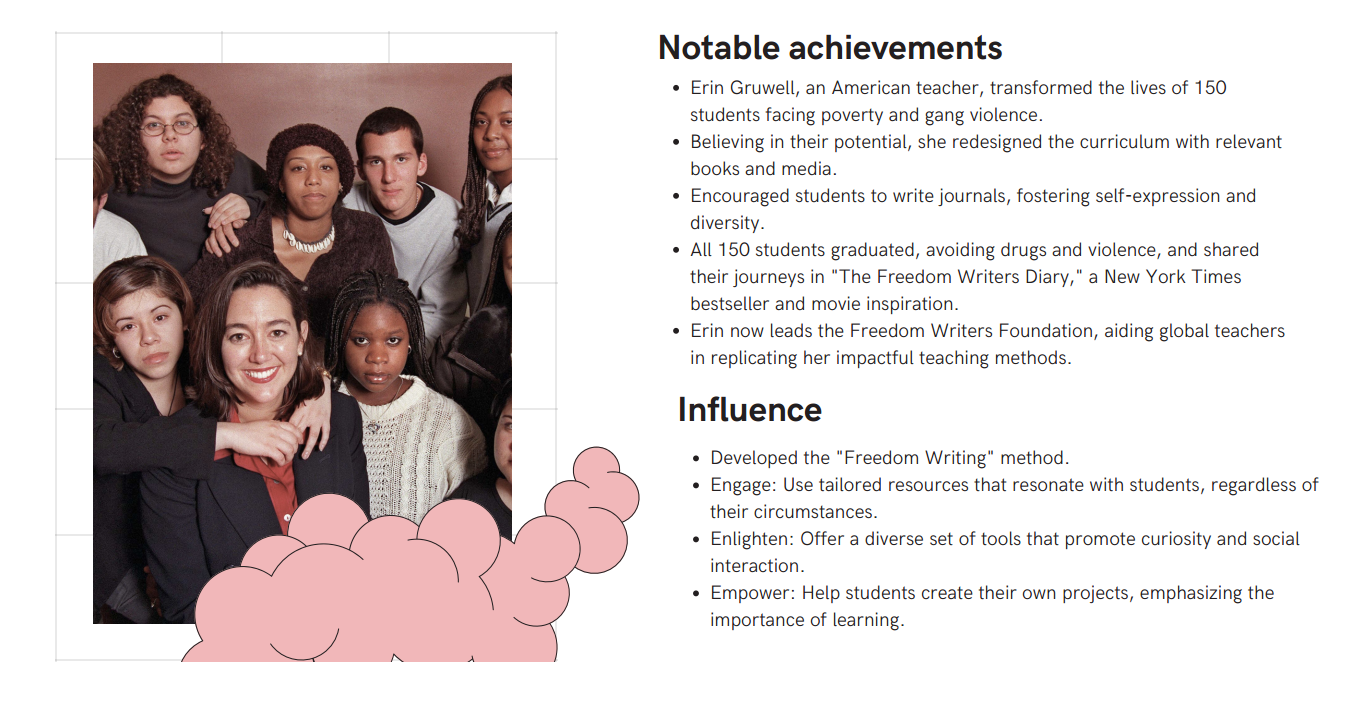
Current Views on Education & Subject Area
"I realized if you can change a classroom, you can change a community, and if you change enough communities you can change the world."
-Erin Gruwell
Throughout my teaching career, my vision of education has evolved significantly. It was during one of my vocational education (VE) specialization classes that I was able to clearly articulate this vision. This clarity came when we discussed educators who inspired us, and I chose Erin Gruwell, whose quote I shared earlier.
In my vision of education, the most important aspects are the subject itself, the students, their stories, and how their diversity enriches the classroom. The goal is to create a third space where all our differences come together in harmony (Casal & Méndez, 2020).
My perspective on education has changed over time, and in this section, I will share both my previous and current views.
- Previous vision:
"As a future modern foreign language teacher my vision is to...
• Help my students develop their identities, and prepared them to enter the world and serve their fellow citizens.
• Assist pupils in developing critical democratic principles, such as youth citizenship, community, and equality (Richardson, 2019).
• Foster a culture of learning and risk-taking, in an educational atmosphere that is both stimulating and safe (Geerts, 2018).
• Promote critical thinking, so that children can become strong and thoughtful leaders in their school and community.
• Prepare students for life after high school, including employment, community service, and Interpersonal relationships.
• Cultivate resilient individuals, that believe in themselves and are ready to overcome life's adversities (Ur, 2012)"
Diversity was not the central component of my view of education, even though I was somewhat aware of it; rather, I saw it more as a list of tasks to be accomplished. But having completed three fruitful internships and my journey to become a teacher, I have come to the realization that, before focusing on a topic, one must focus on the individual, the students, and the aspects of diversity that contribute to their identity. This is perhaps the most important realization I have made.
- Current vision:
"My educational vision is based on helping each student reach their full potential. As a teacher, I believe in the power of hard work, perseverance, and a strong work ethic, which I strive to instill in my students. To make this vision a reality, the following elements are instrumental: acknowledging my students' diversity, fostering a safe and encouraging learning environment, and encouraging critical thinking and resilience.
To ensure equal educational opportunities, I acknowledge and value the diversity of my students. Every student, regardless of background, brings unique talents, perspectives, and experiences to our classroom. I believe in creating an inclusive educational environment where everyone is treated fairly and with respect, fostering a sense of belonging and acceptance among students (Murphy & Tobin, 2011). To me, inclusive education goes beyond simply recognizing diversity. It entails creating an environment in which all students are welcomed and appreciated, regardless of their cultural, ideological, or gender differences. Making space in my classroom for different voices, ideas, and cultures is part of celebrating diversity. It also entails creating an environment in which students are not only permitted but encouraged to express their identities (Sapon-Shevin, 2013).
As an educator, I also emphasize the importance of creating a safe and stimulating learning environment in which making mistakes is viewed as an opportunity for growth and learning rather than failure (Geerts, 2018). The classroom should be a place where everyone feels safe, for instance, when conflicts arise, my goal is to serve as a mediator, assisting students in navigating disputes constructively (Ur, 2012). My goal is to assist my students in developing their identities and preparing them to serve their fellow citizens in a diverse world. Recognizing and nurturing each student's unique individuality is central to my practice (Walters & Frei, 2007), as is facilitating an inclusive and stimulating educational environment
My vision also includes encouraging critical thinking. I want to help students grow into strong and thoughtful leaders in their school and community, capable of making informed decisions, creative problem-solving, and addressing societal issues with empathy and understanding (Richardson, 2019).
Preparing students for life after high school is also a priority in my classroom. This includes developing skills necessary for employment, community service, and interpersonal relationships. Finally, I strive to develop resilient individuals who believe in themselves and are prepared to overcome life's adversities (Ur, 2012). By creating a positive and supportive learning environment, I hope to empower my students by assisting them in developing the resilience and self-belief required to face challenges with confidence and optimism.
In summary, my vision of education is grounded in celebrating diversity, fostering inclusivity, and empowering students to become active, thoughtful, and resilient members of their community. I am committed to continuously refining my teaching practice to best serve the needs of all my students, irrespective of their backgrounds or identities. In my teaching practice, I strive to uphold these values, fostering an inclusive, supportive classroom environment where students feel safe to learn, grow, and express themselves. I am committed to constantly improving my skills and approaches to help students navigate their learning journey and prepare them for life's many challenges."
Sources:
Casal, I. I., & Méndez, C. R. (2020). Mediación y competencia comunicativa intercultural en la enseñanza del español LE/L2. Journal Of Spanish Language Teaching, 7(2), 89-98. https://doi.org/10.1080/23247797.2020.1853368
Geerts, W. (2018). The teachers' handbook.
Murphy, J., & Tobin, K. (2011). Inclusive education: A critical analysis.
Richardson, V. (2019). Teaching for critical thinking.
Sapon-Shevin, M. (2013). Widening the circle: The power of inclusive classrooms.
Ur, P. (2012). A course in language teaching: Practice and theory
